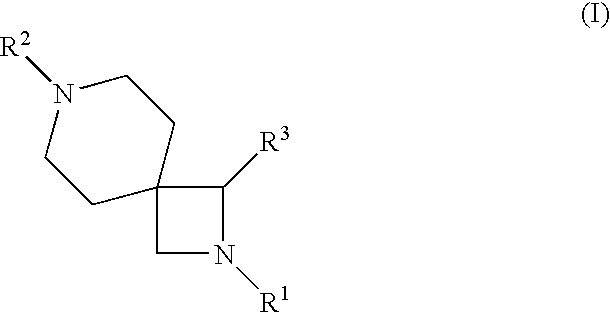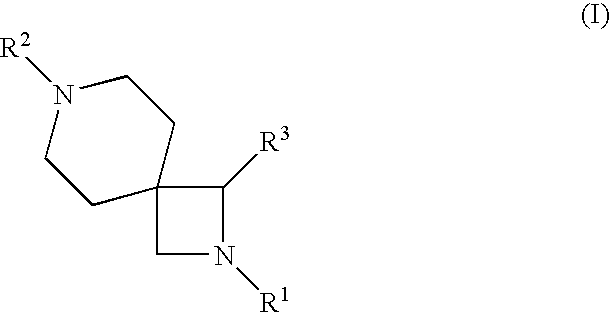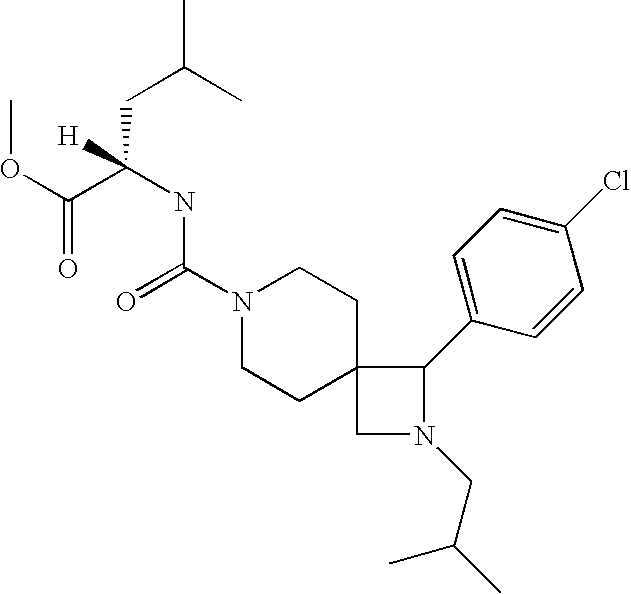Treating pain, diabetes, and disorders of lipid metabolism
a lipid metabolism and disease technology, applied in the field of treating pain, diabetes, and disorders of lipid metabolism, can solve problems such as failure of pancreatic beta-cells
- Summary
- Abstract
- Description
- Claims
- Application Information
AI Technical Summary
Problems solved by technology
Method used
Image
Examples
example b10-1
2-{[1-(4-Chloro-phenyl)-2-isopropyl-2,7-diaza-spiro[3.5]nonane-7-carbonyl]-amino}-3-methyl-pentanoic acid methyl ester
[0197]
Step A: Preparation of 1,1-Dimethylethyl 1-oxo-3-(4-chlorophenyl)-2,7-diazaspiro[3.5]nonane-7-carboxylate (B5-1)
[0198] In a dry 250 mL, 3-necked flask, add 4-chlorobenzaldehyde (6.51 g) and dry THF (20 mL) and cool to −30 C. Add 1M lithium bis(trimethylsilyl)amide in THF (47 mL) dropwise keeping the temperature at ˜30 C. Then, warm the reaction mixture to 0 C for 30 min. (Solution A)
[0199] In a dry 250 mL flask, under a nitrogen atmosphere, add diisopropylamine (6.1 mL) and dry THF (10 mL) and cool to 0 C. Add 2.5 M n-butyl lithium in hexane (17.4 mL, 43.5 mmole) dropwise and let stir at −60 C for 25 min. Then, add a solution of ethyl 1-tert-butoxycarbonylpipendine-4-carboxylate (1) (9.3 g) in dry THF (10 mL) dropwise maintaining the temperature at −65 to −55 C for 90 min. (Solution B) Add solution A to solution B dropwise maintaining temperature at −55 to −...
example b11-1
Preparation of 1,1-Dimethylethyl 1-phenyl)-2,7-diazaspiro[3.5]nonane-7-carboxylate
[0223]
[0224] Under an argon atmosphere, place lithium aluminum hydride 5.3 g) in a dry 250 mL RB 3-necked flask. Add diethyl ether (molecular sieves) (100 mL). Cool mixture to 0° C., and add aluminum chloride (5.97 g) portionwise maintaining temperature at −5° to 5°. Stir the resulting mixture for 30 min. Under argon, filter this mixture into a nitrogen purged 1 liter RB 3-necked flask. Wash the cake with dry diethyl ether (100 mL). Cool the filtrate to −45 C, and add 1,1-dimethylethyl 1-oxo-3-(4-chlorophenyl)-2,7-diazaspiro[3.5]nonane-7-carboxylate (8.40 g) in dry (molecular sieve) THF (300 mL) dropwise maintaining the temperature at −40° to −45° C. Warm the mixture slowly to −20° C. (−25° to −18°), and monitor an aliquot quenched with 2.5N NaOH by TLC on silica gel using CH2CO2:MeOH 9:1 as eluant. After 2 h, cool the reaction mixture to −30° C. and slowly quench 10% NaOH (temperature to −5 C). Extra...
PUM
| Property | Measurement | Unit |
|---|---|---|
| Molar density | aaaaa | aaaaa |
| Molar density | aaaaa | aaaaa |
| Molar density | aaaaa | aaaaa |
Abstract
Description
Claims
Application Information
 Login to View More
Login to View More - R&D
- Intellectual Property
- Life Sciences
- Materials
- Tech Scout
- Unparalleled Data Quality
- Higher Quality Content
- 60% Fewer Hallucinations
Browse by: Latest US Patents, China's latest patents, Technical Efficacy Thesaurus, Application Domain, Technology Topic, Popular Technical Reports.
© 2025 PatSnap. All rights reserved.Legal|Privacy policy|Modern Slavery Act Transparency Statement|Sitemap|About US| Contact US: help@patsnap.com



